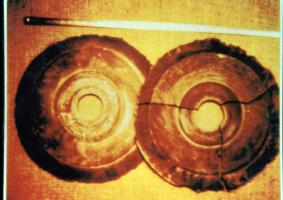Copy Link
Add to Bookmark
Report
CHiNA 07

***************************************************************************
* *
* The Telephone Works *
* Egghead Dude *
* CHiNA CHiNA *
***************************************************************************
Welcome to CHiNA Educational InfoFile Series II, # 3. Once again,
be looking for new files weekly for the next few weeks until school starts
again. And contrary to Megaton Man's belief, we are still very much alive
and in production. If he tells you otherwise, kindly call him a peasant
and tell him to fuck himself...if you want. Enjoy!
Here are the standards in Telephone Color Coding:
Telephone circuits are paired as 'tip' and 'ring' wires. On POTS
(plain old telephone service) tip is 0 volts and ring is -48 volts (tip is
not 'ground' though as it is a blanced line). The pairs must be
distinguishable from one another easily so they are colour coded. The
colour of the wire indicates whether it is tip or ring. In a quad wire
green and black are tip while red and yellow are ring.
pair# tip colour ring colour
_____ __________ ___________
1 white blue
2 white orange
3 white green
4 white brown
5 white slate (silver)
6 red blue
7 red orange
8 red green
9 red brown
10 red slate
11 black blue
12 black orange
13 black green
14 black brown
15 black slate
16 yellow blue
17 yellow orange
18 yellow green
19 yellow brown
20 yellow slate
21 violet (purple) blue
22 violet orange
23 violet green
24 violet brown
25 violet slate
An individual wire is identified by it's colour and the colour of
it's stripe. The main colour determines whether it is tip or ring while
the stripe identifies it's pair (i.e. a black wire with a blue stripe is
tip of pair 11). In many cables the stripe is missing in which case the
pairs are distinguished by the way they are twisted, by pulling back the
sheath pairs are more obvious.
As you can see there are only 5 tip colors and 5 ring colours (5
x 5 = 25). a 100 pair cable is made up of four of these 25 pair bundles.
The first bundle is wrapped by a white/blue binder string, the second by a
white/orange binder, the third by a white/green and the fourth by a
white/brown. This scheme can be extended infinitum.
Some folks think that the order is:
Pair Tip Ring
1 RED GRN
2 YEL BLK
3 BLU WHT,
and that the 1st pair was backwards in a modular connector compared to the
rest.
Wrong. The polarity is off. Modular connectors reverse the polarity
so they make the issue pretty confusing. A modular line cord (that is a
properly made _telephone_ line cord) has a flat topology such that when
laid on a table the top of both connectors is up. This means that a
reversal (polarity wise) takes place. Tip becomes ring on all pairs (the
wire is a ribbon in theory). the top of both connectors is up. A 'set'
jack (the one inside the telephone) is wired backwards to compensate.
In addition, the system employed throughout the (used-to-be) Bell
System was actually very simple. There wer five colors assigned to "tip"
and five colors assigned to "ring". This gives a total combination of
twenty-five pairs (very convenient!).
The colors assigned to the "tip" are;
white wt
red rd
black bk
yellow yl
violet vi
The colors assigned to the "ring" are;
blue bl
orange or
green gr
brown br
slate sl (sometimes mistakenly called gray)
Standard phone convention is to identify the "tip" first and then the
"ring" when referring to a pair. Thus, the first five pairs of a telephone
cable are the "white" pairs;
white/blue wt/bl
white/orange wt/or
white/green wt/gr
white/brown wt/bn
white/slate wt/sl
The next five are the "red" pairs:
red/blue rd/bl
red/orange rd/or
red/green rd/gr
red/brown rd/bn
red/slate rd/sl
And so on, until all twenty five pairs are identified. What happens
when there are more than twenty-five pairs in a cable? Simple, enclose
each twenty-five pair group in a color coded binder. And guess what the
color coding is for the binder. Yep, the same as the wires in the binder.
The first binder group is the "white/blue" binder the second is the
"white/orange" binder, and so on. If it is necessary to refer to the
twenty-sixth pair of a fifty pair cable it is referred to as "two
white/blue" or 2-wt/bl. The seventy-ninth pair in a one-hundred pair cable
is called "four white/brown" or 4-wt/bn. This all holds true for the first
twenty-four binders in a cable. The twenty-fifth binder is a little
different, and my recollection is a little hazy but I believe the binder
colors are white-white-blue. Yes that's two whites and a blue. It might be
two blues and a white. It's been a long time since I was in a cable over
six hundred pairs. One thing I know for sure is that they double up on one
of the binder colors after the twenty-fourth binder group.
There is also a convention for the positioning the pairs on
connecting blocks. The Ring is usually on the Right and the Tip is
usually on the Top. As you can see there is a pattern here, Ring-Red-
Right and Tip-Top. I guess this was done to make it easier for us dumb
installers to remember! |-)
The only difference in the color coding between telephone cable (the
stuff used outside and strung along poles or underground in conduit) and
telephone inside wiring (the gray colored stuff in the walls and up in the
ceiling) is that the inside wire has each pair traced with the color of
its mate. That is, the first pair is a white wire with a blue tracer and
its mate is blue with a white tracer. This is done to avoid "splitting" a
pair. Splitting is getting the ring of one pair and the tip of another.
In outside phone cable each pair is twisted with its mate and the chances
of splitting a pair are not as great (although it's been known to happen
;-)).
With wiring done inside a house, a little history is in order. Back
when we had party-lines,(I know, we still do, but very few still in
service and none available for new service) three wires were necessary
because a ground was required to make the bell ring. So, the original
phone wiring had three conductors, red, green and yellow. Red and green
were ring and tip respectively and yellow was the ground. Then people
started getting away from party lines and into princess and trimline
phones with lights in the dial. The yellow was no longer the ground and a
black wire was added and the yellow and black were used to supply power
for the lamps from a small transformer. Time marches on, and now people
are getting second lines installed in their homes. Since the new phones
get the power for their lamps from the phone line directly, the yellow
and black are now "spare". The yellow is usually the ring and black is
the tip. Of course, houses that have been pre-wired with six-pair inside
wire would normally have line 1 on the white/blue pair and line 2 on the
white/orange pair. In many pre-wire installations I have found that the
sixth pair (red/blue) was used for transformer power, although I don't
believe that was ever an official practice.
Written by: Egghead Dude Edited by: The Conflict
Golf City BBS
CHiNA Node #5
Hope you enjoyed this one, and once again, look for more! Please
distribute this file freely, and if you really must speak to CHiNA,
contact us on one of our member boards (a node list should be available
wherever you receieved this file). Thanks for you support!
A big HELLO to Mr. X, The Maestro, Barimor (hear you're doing wonders
for the FiRM!), Jolly Green Giant, Feetsack, Lord Blix, Maxwell Smart, The
Viper, etc...if you want to be said HELLO to, too bad, we don't like you!
Really...we'll be seeing you!




















